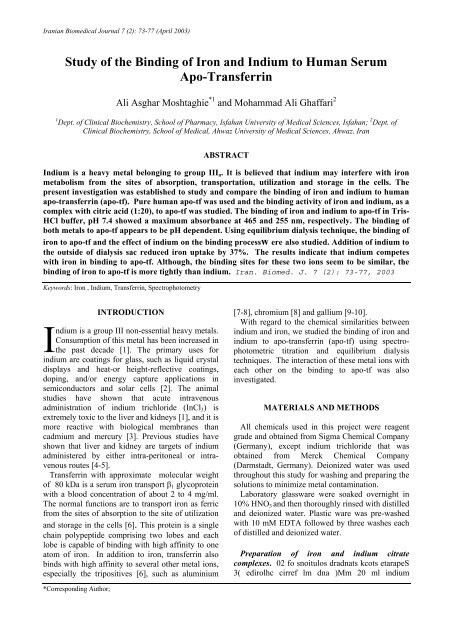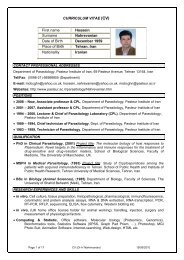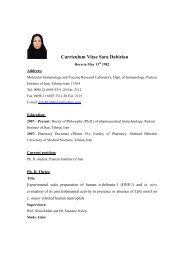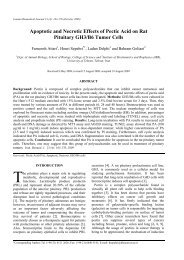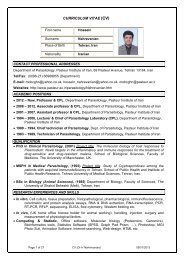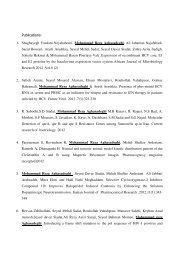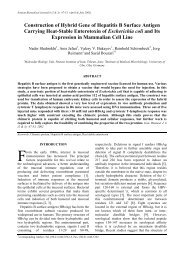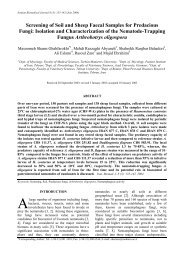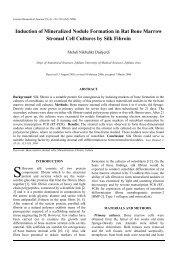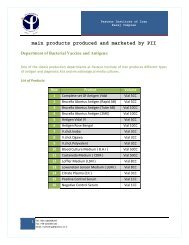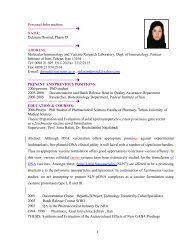Study of the Binding of Iron and Indium to Human Serum Apo ...
Study of the Binding of Iron and Indium to Human Serum Apo ...
Study of the Binding of Iron and Indium to Human Serum Apo ...
You also want an ePaper? Increase the reach of your titles
YUMPU automatically turns print PDFs into web optimized ePapers that Google loves.
Iranian Biomedical Journal 7 (2): 73-77 (April 2003)<strong>Study</strong> <strong>of</strong> <strong>the</strong> <strong>Binding</strong> <strong>of</strong> <strong>Iron</strong> <strong>and</strong> <strong>Indium</strong> <strong>to</strong> <strong>Human</strong> <strong>Serum</strong><strong>Apo</strong>-TransferrinAli Asghar Moshtaghie *1 <strong>and</strong> Mohammad Ali Ghaffari 21 Dept. <strong>of</strong> Clinical Biochemistry, School <strong>of</strong> Pharmacy, Isfahan University <strong>of</strong> Medical Sciences, Isfahan; 2 Dept. <strong>of</strong>Clinical Biochemistry, School <strong>of</strong> Medical, Ahwaz University <strong>of</strong> Medical Sciences, Ahwaz, IranABSTRACT<strong>Indium</strong> is a heavy metal belonging <strong>to</strong> group III a . It is believed that indium may interfere with ironmetabolism from <strong>the</strong> sites <strong>of</strong> absorption, transportation, utilization <strong>and</strong> s<strong>to</strong>rage in <strong>the</strong> cells. Thepresent investigation was established <strong>to</strong> study <strong>and</strong> compare <strong>the</strong> binding <strong>of</strong> iron <strong>and</strong> indium <strong>to</strong> humanapo-transferrin (apo-tf). Pure human apo-tf was used <strong>and</strong> <strong>the</strong> binding activity <strong>of</strong> iron <strong>and</strong> indium, as acomplex with citric acid (1:20), <strong>to</strong> apo-tf was studied. The binding <strong>of</strong> iron <strong>and</strong> indium <strong>to</strong> apo-tf in Tris-HCl buffer, pH 7.4 showed a maximum absorbance at 465 <strong>and</strong> 255 nm, respectively. The binding <strong>of</strong>both metals <strong>to</strong> apo-tf appears <strong>to</strong> be pH dependent. Using equilibrium dialysis technique, <strong>the</strong> binding <strong>of</strong>iron <strong>to</strong> apo-tf <strong>and</strong> <strong>the</strong> effect <strong>of</strong> indium on <strong>the</strong> binding process w ere also studied. Addition <strong>of</strong> indium <strong>to</strong><strong>the</strong> outside <strong>of</strong> dialysis sac reduced iron uptake by 37%. The results indicate that indium competeswith iron in binding <strong>to</strong> apo-tf. Although, <strong>the</strong> binding sites for <strong>the</strong>se two ions seem <strong>to</strong> be similar, <strong>the</strong>binding <strong>of</strong> iron <strong>to</strong> apo-tf is more tightly than indium. Iran. Biomed. J. 7 (2): 73-77, 2003Keywords: <strong>Iron</strong> , <strong>Indium</strong>, Transferrin, Spectropho<strong>to</strong>metryINTRODUCTION<strong>Indium</strong> is a group III non-essential heavy metals.Consumption <strong>of</strong> this metal has been increased in<strong>the</strong> past decade [1]. The primary uses forindium are coatings for glass, such as liquid crystaldisplays <strong>and</strong> heat-or height-reflective coatings,doping, <strong>and</strong>/or energy capture applications insemiconduc<strong>to</strong>rs <strong>and</strong> solar cells [2]. The animalstudies have shown that acute intravenousadministration <strong>of</strong> indium trichloride (InCl 3 ) isextremely <strong>to</strong>xic <strong>to</strong> <strong>the</strong> liver <strong>and</strong> kidneys [1], <strong>and</strong> it ismore reactive with biological membranes thancadmium <strong>and</strong> mercury [3]. Previous studies haveshown that liver <strong>and</strong> kidney are targets <strong>of</strong> indiumadministered by ei<strong>the</strong>r intra-peri<strong>to</strong>neal or intravenousroutes [4-5].Transferrin with approximate molecular weight<strong>of</strong> 80 kDa is a serum iron transport β 1 glycoproteinwith a blood concentration <strong>of</strong> about 2 <strong>to</strong> 4 mg/ml.The normal functions are <strong>to</strong> transport iron as ferricfrom <strong>the</strong> sites <strong>of</strong> absorption <strong>to</strong> <strong>the</strong> site <strong>of</strong> utilization<strong>and</strong> s<strong>to</strong>rage in <strong>the</strong> cells [6]. This protein is a singlechain polypeptide comprising two lobes <strong>and</strong> eachlobe is capable <strong>of</strong> binding with high affinity <strong>to</strong> onea<strong>to</strong>m <strong>of</strong> iron. In addition <strong>to</strong> iron, transferrin alsobinds with high affinity <strong>to</strong> several o<strong>the</strong>r metal ions,especially <strong>the</strong> tripositives [6], such as aluminium[7-8], chromium [8] <strong>and</strong> gallium [9-10].With regard <strong>to</strong> <strong>the</strong> chemical similarities betweenindium <strong>and</strong> iron, we studied <strong>the</strong> binding <strong>of</strong> iron <strong>and</strong>indium <strong>to</strong> apo-transferrin (apo-tf) using spectropho<strong>to</strong>metrictitration <strong>and</strong> equilibrium dialysistechniques. The interaction <strong>of</strong> <strong>the</strong>se metal ions wi<strong>the</strong>ach o<strong>the</strong>r on <strong>the</strong> binding <strong>to</strong> apo-tf was alsoinvestigated.MATERIALS AND METHODSAll chemicals used in this project were reagentgrade <strong>and</strong> obtained from Sigma Chemical Company(Germany), except indium trichloride that wasobtained from Merck Chemical Company(Darmstadt, Germany). Deionized water was usedthroughout this study for washing <strong>and</strong> preparing <strong>the</strong>solutions <strong>to</strong> minimize metal contamination.Labora<strong>to</strong>ry glassware were soaked overnight in10% HNO 3 <strong>and</strong> <strong>the</strong>n thoroughly rinsed with distilled<strong>and</strong> deionized water. Plastic ware was pre-washedwith 10 mM EDTA followed by three washes each<strong>of</strong> distilled <strong>and</strong> deionized water.Preparation <strong>of</strong> iron <strong>and</strong> indium citratecomplexes. 02fo snoitulos dradnats kcots etarapeS3 ( edirolhc cirref lm d na )Mm20 ml indium*Corresponding Author;
Moshtaghie & Ghaffaritrichloride (3 mM) were prepared in deionizedwater <strong>and</strong> mixed with <strong>the</strong> equal volume <strong>of</strong> 60 mMcitric acid solution. The solutions were adjusted <strong>to</strong>pH 7.4 with 1 N NaOH <strong>and</strong> made up <strong>to</strong> a finalvolume <strong>of</strong> 50 ml by deionized water [10].Spectropho<strong>to</strong>metric titration technique for metalbinding <strong>to</strong> apo-tf. The binding <strong>of</strong> iron <strong>and</strong>/orindium <strong>to</strong> apo-tf was carried out usingspectropho<strong>to</strong>metric titration technique. Thistechnique was performed at room temperature(25°C). To achieve spectropho<strong>to</strong>metric titration forbinding <strong>of</strong> ei<strong>the</strong>r iron or indium <strong>to</strong> apo-tf, 200 µlapo-tf (107.5 µM) in 50 mM Tris-HCL buffer, pH7.4, 0.02M NaHCO 3 , was added <strong>to</strong> a st<strong>and</strong>ard 1 cmpre-acid washed glass tubes. Aliquots <strong>of</strong> 1.2 mMiron-citrate (1:20) or 1.2 mM indium-citrate (1:20)complexes were <strong>the</strong>n added <strong>to</strong> <strong>the</strong> tubes <strong>and</strong> <strong>the</strong>volumes made up <strong>to</strong> 2 ml with <strong>the</strong> same buffer, <strong>the</strong>ymixed vigorously by vortexing. The tubes werecapped <strong>and</strong> left for up <strong>to</strong> 2 h at room temperature.The absorbance <strong>of</strong> <strong>the</strong> test tubes was taken usingPerkin-Elmer UV/Vis spectropho<strong>to</strong>meter model551-S [8, 10].Equilibrium dialysis technique for metal binding<strong>to</strong> apo–tf. The binding <strong>of</strong> iron <strong>to</strong> human apo-tf <strong>and</strong><strong>the</strong> effect <strong>of</strong> indium on iron binding activity werealso investigated using equilibrium dialysis at 2-4°C. Two ml solution <strong>of</strong> apo-tf (21.5 µM) wasplaced in a dialysis sac opened <strong>to</strong> <strong>the</strong> atmosphere,which was immersed in a glass vessel contain 160ml 50 mM Tris-HCl buffer, pH 7.4, 0.02 MNaHCO 3 [10]. Fifty µl <strong>of</strong> iron (1.2 mM) as ferriccitrateor indium r o indium (1.2 mM) as indiumcitratesolutions were added at time intervals <strong>to</strong> <strong>the</strong>buffer surrounding <strong>the</strong> dialysis sac with <strong>the</strong> aid <strong>of</strong> amagnetic stirrer. After 24 h, 100 µl <strong>of</strong> sample frominside <strong>and</strong> 100 µl from outside <strong>of</strong> <strong>the</strong> dialysis sacwas removed <strong>and</strong> analyzed for iron. <strong>Iron</strong>concentration was determined using Brittenhammethod [11]. The binding constant <strong>of</strong> iron <strong>to</strong> apo-tfwithout indium was calculated using Scatchardrelationship (i.e. [B]/[F] = -1/K[B] + n[E] T /K S ) <strong>and</strong>plot <strong>of</strong> [B]/[F] against [B], [12]. Where [B] isconcentration <strong>of</strong> bound ion <strong>to</strong> protein, [F] isconcentration <strong>of</strong> free ion, n is number <strong>of</strong> bindingsite, [E] T is concentration <strong>of</strong> <strong>to</strong>tal protein <strong>and</strong> K S is<strong>the</strong> dissociation constant.The effect <strong>of</strong> pH on <strong>the</strong> binding <strong>of</strong> iron <strong>and</strong>indium <strong>to</strong> apo-tf. To a series <strong>of</strong> pre-acid washedtest tubes containing 200 µl apo-tf (107.5 µM), 45µl <strong>of</strong> iron solution (1.2 mM) or indium (1.2 mM) as74complex with citric acid were added <strong>and</strong> <strong>the</strong>volumes made up <strong>to</strong> 2 ml by Tris-HCl buffer withvarying pH within <strong>the</strong> range <strong>of</strong> 5.8 <strong>to</strong> 8. Thesolutions were vortexed <strong>and</strong> incubated for 2h atroom temperature. The absorbance <strong>of</strong> <strong>the</strong> test tubeswas measured by spectropho<strong>to</strong>meter.Metal ions interactions with each o<strong>the</strong>r forbinding <strong>to</strong> apo-tf. The binding <strong>of</strong> iron <strong>to</strong> apo-tf <strong>and</strong><strong>the</strong> effect <strong>of</strong> indium on iron binding activity <strong>and</strong>vice versa, were also investigated by spectropho<strong>to</strong>metrictitration. Initially, <strong>the</strong> effect <strong>of</strong> indiumon iron binding <strong>to</strong> apo-tf was studied. Prepared apotf(107.5 µM) in 200 µl, in 50 mM Tris-HCl buffer,pH 7.4, 0.02M NaHCO 3 was added <strong>to</strong> pre-acidwashed test tubes first. Then 55 µl <strong>of</strong> indium (1.2mM), as complex with citrate (1:20) <strong>and</strong> 0-55 µl <strong>of</strong>iron (1.2 mM) as complex with citric acid wereadded <strong>to</strong> <strong>the</strong> series <strong>of</strong> tubes <strong>and</strong> <strong>the</strong> volumes weremade up <strong>to</strong> 2 ml with <strong>the</strong> same buffer. The solutionswere <strong>the</strong>n mixed vigorously by vortexing <strong>and</strong> leftfor up <strong>to</strong> 2 h at room temperature. The absorbances<strong>of</strong> <strong>the</strong> test tubes were measured at 465 nm. Thesame experiment was also repeated without indium.Next, <strong>the</strong> effect <strong>of</strong> iron on binding <strong>of</strong> indium <strong>to</strong>apo-tf was studied. As mentioned above 200 µl <strong>of</strong>apo-tf was added <strong>to</strong> a series <strong>of</strong> test tubes. <strong>Iron</strong>solutions (55 µl) <strong>and</strong> 0-55 µl <strong>of</strong> indium solutionwere added <strong>and</strong> <strong>the</strong> volumes were made up <strong>to</strong> 2 mlwith Tris-HCl buffer, pH 7.4. The absorbance <strong>of</strong> <strong>the</strong>test tubes was measured at 255 nm. This study wasalso repeated in <strong>the</strong> absence <strong>of</strong> iron.Absorbance0.60.50.40.30.20.10Tf-FeTf-InAp o -Tf200 300 400 500Wavelength (nm)Fig. 1. Absorption spectrum (200-550 nm) <strong>of</strong> apo-tf, irontransferrin<strong>and</strong> indium-transferrin. ([<strong>Apo</strong>-tf] = 10.75 µM, [Fe +3 ]= [In +3 ] = 27 µM, pH 7.4, t= 25°C).
Iranian Biomedical Journal 7 (2): 73-77 (April 2003)A (465 nm)0.120.10.080.060.040.020ARESULTSThe absorption <strong>of</strong> apo-tf, iron-transferrin <strong>and</strong>indium-transferrin complexes was measured first.The results in Figure 1 show that <strong>the</strong> absorptionspectrum <strong>of</strong> <strong>the</strong> indium-transferrin complex has twopeaks at 280 <strong>and</strong> 255 nm. <strong>Iron</strong>-transferrin showed abroad peak at 465 <strong>and</strong> 280 nm <strong>and</strong> apo-tf at 280 nm.The effect <strong>of</strong> different pH within <strong>the</strong> range <strong>of</strong> 5.8<strong>to</strong> 8 on <strong>the</strong> binding <strong>of</strong> iron <strong>and</strong> indium <strong>to</strong> apo-tfwere studied. It showed that both iron <strong>and</strong> indiumbind <strong>to</strong> apo–tf mostly at pH 7.4. The lower <strong>the</strong> pH,<strong>the</strong> less binding <strong>of</strong> <strong>the</strong>se metals <strong>to</strong> apo-tf (Fig. 2).0.55.6 6.1 6.6 7.1 7.6 8.1BpHThe effect <strong>of</strong> different amounts <strong>of</strong> iron (0 <strong>to</strong> 33µM) on binding <strong>of</strong> apo-tf <strong>and</strong> <strong>the</strong> effect <strong>of</strong> indium(33 µM) on iron up-take by apo-tf wereinvestigated. Initially, it was found that eachmolecule <strong>of</strong> apo-tf was saturated withapproximately 2 a<strong>to</strong>ms <strong>of</strong> iron, corresponding <strong>to</strong> 1.4µg iron per mg transferrin (Fig. 3A, curve Tf-Fe),when indium (33 µM) was added, <strong>the</strong> absorbance <strong>of</strong>transferrin-iron at 465 nm was reduced byapproximately 16% (Fig. 3A, curve Tf-Fe+In). Thebinding effect <strong>of</strong> different amounts <strong>of</strong> indium (o <strong>to</strong>33 µM) as a complex with citric acid <strong>and</strong> <strong>the</strong> effect<strong>of</strong> iron on indium binding <strong>to</strong> apo-tf were alsoinvestigated. The results show that each molecule <strong>of</strong>apo-tf was also saturated with approximately 2a<strong>to</strong>ms <strong>of</strong> indium, corresponding <strong>to</strong> 2.85 µg indiumper mg transferrin (Fig. 3B, curve Tf-In). Thepresence <strong>of</strong> iron (33 µM) in <strong>the</strong> reaction mixturesreduced <strong>the</strong> absorbance <strong>of</strong> transferrin-indiumcomplex at 255 nm by approximately 48% (Fig. 3B,curve Tf-In+Fe).A (465 nm)0.140.120.10.080.060.040.020A0 0.5 1 1.5 2 2.5 3 3.5Molar ratio <strong>of</strong> Fe+3 / TfTf-FeTf-Fe+In0.40.60.5BA (255 nm)0.30.2A (255 nm)0.40.30.20.105.6 6.1 6.6 7.1 7.6 8.1pHFig. 2. Effect <strong>of</strong> different pH (5.8 <strong>to</strong> 8) on iron binding (A)<strong>and</strong> ( 8 . 5 <strong>to</strong> 8) noig nidnib nor(A) <strong>and</strong> indium binding (B) <strong>to</strong>apo-tf. Each point is <strong>the</strong> mean <strong>of</strong> three separate experiments.([<strong>Apo</strong>-tf] = 10.75 µM, [Fe= +3 ] = [In +3 ] = 27 µM, t = 25°C).0.10Tf-InTf-In+Fe0 0.5 1 1.5 2 2.5 3 3.5Molar ratio <strong>of</strong> In+3 / TfFig. 3. Spectropho<strong>to</strong>metric titration <strong>of</strong> human apo-tf withdifferent concentration <strong>of</strong> i n or(0 <strong>to</strong> 33 µM) in <strong>the</strong> presence <strong>and</strong>absence <strong>of</strong> indium (33 µM) (A) <strong>and</strong> also spectropho<strong>to</strong>metrictitration <strong>of</strong> human apo-tf with different concentrations <strong>of</strong>indium (0–33 µM) in <strong>the</strong> presences <strong>and</strong> <strong>the</strong> absence <strong>of</strong> iron (33µM ) (B). Each point is <strong>the</strong> mean <strong>of</strong> three experiments. ([<strong>Apo</strong>tf]= 10.75 µM, pH 7.4, t = 25°C).75
Moshtaghie & GhaffariIn order <strong>to</strong> confirm <strong>the</strong> binding <strong>of</strong> iron <strong>and</strong>/orindium <strong>to</strong> apo-tf, equilibrium dialysis technique wasused (Fig. 4A). The binding <strong>of</strong> iron <strong>to</strong> apo-tf <strong>and</strong><strong>the</strong> effect <strong>of</strong> indium on <strong>the</strong> binding activitypresented in Figure 4A. In <strong>the</strong> presence <strong>of</strong> indium asa complex with citric acid, approximately 37%reduction in iron binding <strong>to</strong> apo-tf was seen (Fig.4A). Using Scatchard plot analysis <strong>and</strong> <strong>the</strong> data inFigure 4A, <strong>the</strong> binding constant for iron binding <strong>to</strong>apo-tf in <strong>the</strong> absence <strong>of</strong> indium was calculated (Fig.4B). The approximate binding constant for irontransferrincomplex was 8.7 × 10 6 M -1 (Fig. 4B).[ Fe+3 ] bound ( g/dl )[Fe+3] Bound/[Fe+3] Free140120100806040205432100A0 5 10 15 20 25 30By = -0.1144 x + 4.2957[ Fe+3 ] added (µ g )- In+ In0 5 10 15 20 25 30 35 40[Fe+3] Bound (µ mol/L)Fig. 4. The study binding <strong>of</strong> iron <strong>to</strong> apo-tf in <strong>the</strong> absence <strong>and</strong><strong>the</strong> presence <strong>of</strong> indium by equilibrium dialysis (A) <strong>and</strong>Scatchard plot for <strong>the</strong> binding constant <strong>of</strong> iron <strong>to</strong> apo-tf (B).Each point is <strong>the</strong> mean three experiments. ([<strong>Apo</strong>-tf] = 21.5 µMpH 7.4, t = 0-4°C).) .76DISCUSSIONPrevious reports suggest that due <strong>to</strong> biochemicalsimilarities <strong>of</strong> few cations with iron, <strong>the</strong>y mayinterfere with iron metabolism <strong>and</strong> cause somedisorders [7, 13]. Among <strong>the</strong>m are aluminum <strong>and</strong>chromium that could bind <strong>to</strong> serum transferrin <strong>and</strong>cause hypochromic microcytic anemia. In thisstudy, we used spectropho<strong>to</strong>metry technique <strong>to</strong>investigate <strong>the</strong> iron binding <strong>to</strong> serum apo-tf <strong>and</strong> <strong>the</strong>influence <strong>of</strong> indium in <strong>the</strong> binding activity.Absorption spectra obtained from iron <strong>and</strong>/orindium-transferrin complexes indicated twomaximum absorbencies at 465 <strong>and</strong> 255 nm,respectively. According <strong>to</strong> <strong>the</strong> previous reports, <strong>the</strong>maximum absorbance for iron-transferrin complexis 465 nm [10] <strong>and</strong>/or 470 nm [14-15] <strong>and</strong> forindium-transferrin complex is 250 nm [16] <strong>and</strong>/or245 nm [17], which is comparable <strong>to</strong> our findings .When <strong>the</strong> effect <strong>of</strong> pH on <strong>the</strong> binding <strong>of</strong> iron <strong>and</strong>indium <strong>to</strong> apo-tf was studied, it was found that <strong>the</strong>optimal binding activity <strong>of</strong> <strong>the</strong>se two metalsoccurred at pH 7.4. When pH was decreased <strong>to</strong>acidic pH, release <strong>of</strong> <strong>the</strong>se two ions from transferrinoccurred. The release <strong>of</strong> indium was more than iron.This might be due <strong>to</strong> <strong>the</strong> affinity <strong>of</strong> indium <strong>to</strong> -opatf, which is less tightly than iron. The observations<strong>of</strong> Lastas [18] <strong>and</strong> Ponka [19] are in agreement withour results binding <strong>of</strong> iron <strong>and</strong> indium <strong>to</strong> apo-tf arehigher at alkaline pH (pH 7.4) that at acidic pH. Thereduction in iron up-take by indium <strong>and</strong> vice versa,<strong>and</strong> <strong>the</strong> competition <strong>of</strong> iron with indium on <strong>the</strong>o<strong>the</strong>r h<strong>and</strong> suggest that <strong>the</strong>se two metal ions maycompete for <strong>the</strong> same binding site on <strong>the</strong> apo-tf.The same results were obtained when o<strong>the</strong>r trivalentelements were added <strong>to</strong> <strong>the</strong> human apo-tf [8, 15,17]. These competitive binding activities were alsoverified by equilibrium dialysis. In <strong>the</strong> indiumoutside <strong>of</strong> <strong>the</strong> dialysis sac, reduced binding <strong>of</strong> iron<strong>to</strong> apo-tf about 37%. Using this technique <strong>and</strong>Scatchard plot it was found that <strong>the</strong> bindingconstant for iron <strong>to</strong> apo-tf was 8.7 × 10 6M -1 . The difference between obtained bindingconstant for iron <strong>to</strong> apo-tf could be due <strong>to</strong> <strong>the</strong>discrepancies in <strong>the</strong> methods <strong>of</strong> binding <strong>and</strong> <strong>the</strong>fac<strong>to</strong>rs such as composition <strong>of</strong> buffer etc. Overall,it seems that both iron <strong>and</strong> indium bind <strong>to</strong> <strong>and</strong>complete for <strong>the</strong> same sites <strong>of</strong> transferrin. Theoccurrence <strong>of</strong> microcytic anemia in patients withindium overload may, however, be due <strong>to</strong> <strong>the</strong>competition <strong>of</strong> indium with iron in iron metabolism.More investigations should be done <strong>to</strong> elucidate <strong>the</strong>exact mechanism <strong>of</strong> <strong>the</strong>se competitions particularlyat <strong>the</strong> cellular levels.
Iranian Biomedical Journal 7 (2): 73-77 (April 2003)ACKNOWLEDGEMENTSThis project was granted by vice chancellor inresearch affairs <strong>of</strong> Isfahan Medical ScienceUniversity. (Project No. 79182). We thank Mrs.Monsefypour for typing manuscript.REFERENCES1. Chapin, R.E., Harris, M.W., Sidney Hunter, H.E.,Davis, B.J., Collins, B.J. <strong>and</strong> Lockhart, A.C. (1995)The reproductive <strong>and</strong> development <strong>to</strong>xicity <strong>of</strong>indium in <strong>the</strong> Swiss mouse. Fundam. Appl. Toxicol.27: 140-148.2. Blazkd, M.E., Dixon, D., Haskins, E. <strong>and</strong> Rosenthal,C.G. (1994) Pulmonary <strong>to</strong>xicity <strong>to</strong> intra-tracheallyadministered indium trichloride in Fischer 344 rats.. locixoT .lppA .madnuF 22: 2- 1323.93. Suzuki, Y. <strong>and</strong> Matsushita, H. (1969) Interaction <strong>of</strong>metal ions with phospholipid monolayer <strong>and</strong> <strong>the</strong>iracute <strong>to</strong>xicity. Ind. Health 7: 143-154.4. Woods, J.S., Carver, G.T. <strong>and</strong> Fowler, B.A. (1979)Altered regulation <strong>of</strong> hepatic hem metabolism byindium chloride. Toxicol. Appl. Pharmacol. 49:455-461.5. Woods, J.S. <strong>and</strong> Fowler, B.A. (1982) Selectiveinhibition <strong>of</strong> delta amino-levulinic acid dehydrataseby indium chloride in rat kidney: Biochemical <strong>and</strong>ultrastructural studies. Exp. Mol. Pathol. 36: 306-315.6. MacGillivray, R.T.A., Mendez, E., Schewale, J.G.,Sinha, S.K., Lineback, S.J. <strong>and</strong> Brew, K. (1983) Theprimary structure <strong>of</strong> human serum transferrin. J.Biol. Chem. 258: 3545-3553.7. Moshtaghie, A.A. <strong>and</strong> Skillen, A.W. (1986) <strong>Binding</strong><strong>of</strong> aluminium <strong>to</strong> transferrin <strong>and</strong> lact<strong>of</strong>errin.Biochem. Soc. Transactions. 14: 916-917.8. Moshtaghie, A.A., Ani, M. <strong>and</strong> Bazrafshan, M.(1992) comparative binding study <strong>of</strong> aluminium <strong>and</strong>chromium <strong>to</strong> human transferrin. Biol. Trace. Elem.Res. 32: 39-46.9. Harris, W.R. <strong>and</strong> Pecraro, V.L. (1983)Thermodynamic binding constants for galliumtransferrin. Biochemistry 22: 292-299.10. Moshtaghie, A.A. <strong>and</strong> Badii, A. (1996) Comparativebinding studies <strong>of</strong> zinc <strong>and</strong> iron <strong>to</strong> human serumtransferrin. Iran. J. Sci. Tech. 20: 177-188.11. Brittenham, G. (1979) Spectropho<strong>to</strong>metric plasmairon determination from finger puncture specimens.Clin. Chim. Acta. 91: 203-211.12. Scatchard, G. (1984) The interaction <strong>of</strong> proteins forsmall molecules <strong>and</strong> ions. Ann. New Acad. Sci. 51:660-675.13. Punnonen, K., Irjala, K. <strong>and</strong> Rajamaki, A. (1994)<strong>Iron</strong> deficiency anemia is associated with highconcentration <strong>of</strong> transferrin recep<strong>to</strong>r in serum. Clin.Chem. 40: 774-776.14. Aisen, P. (1966) Studies on <strong>the</strong> binding <strong>of</strong> iron <strong>to</strong>transferrin <strong>and</strong> conalbumin. J. Biol. Chem. 241:1666–1671.15. Aisen, P., Aasa, R. <strong>and</strong> Redfield, A.G. (1969) Thechromium, manganese <strong>and</strong> cobalt complexes <strong>of</strong>transferrin. J. Biol. Chem. 244:4628-4633.16. Battistuzzi, G., Calzolai, L., Messori, L. <strong>and</strong> Sola,M. (1995) Metal induced conformationalheterogeneity <strong>of</strong> transferrins: A spectroscopic study<strong>of</strong> indium (III) <strong>and</strong> o<strong>the</strong>r metal (III) substitutedtransferrins. Biochem. Biophys. Res. Commun. 206:161-170.17. Li, H., Sadler, P.J. <strong>and</strong> Sun, H. (1996) Unexpectedlystrong binding <strong>of</strong> a large metal ion (Bi) <strong>to</strong> humanserum transferrin. J. Biol. Chem. 271: 9483-9489.18. Lastas, A.W. (1976) Effect <strong>of</strong> pH upon humantransferrin. Selective labeling <strong>of</strong> <strong>the</strong> two iron bindingsites. British J. Haema<strong>to</strong>l. 32: 341-349.19. Ponka, P. (1997) Tissue specific regulation <strong>of</strong> ironmetabolism <strong>and</strong> hem syn<strong>the</strong>sis: Distinct controlmetabolism in erythroid cells. Blood 89: 1-25.77


